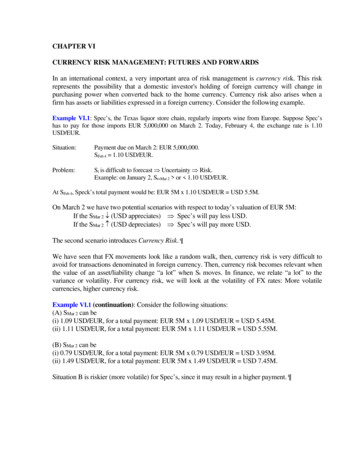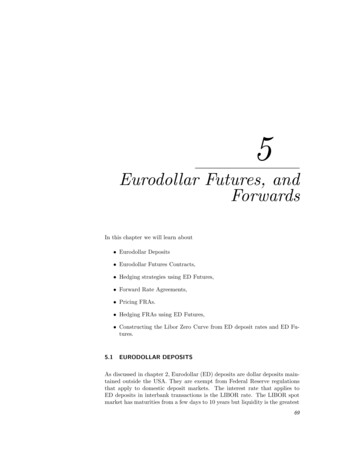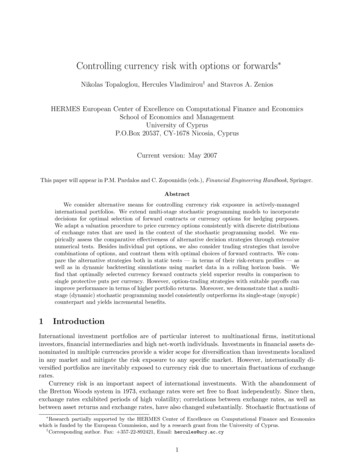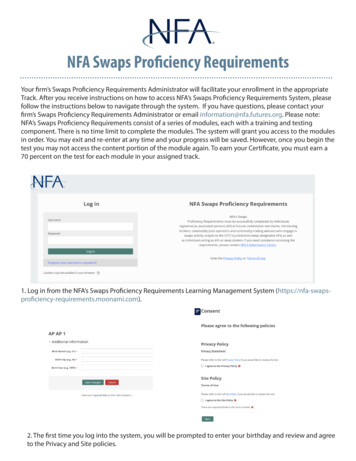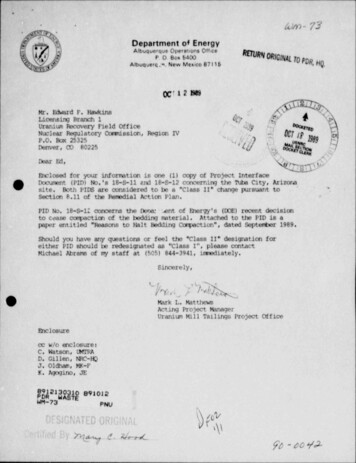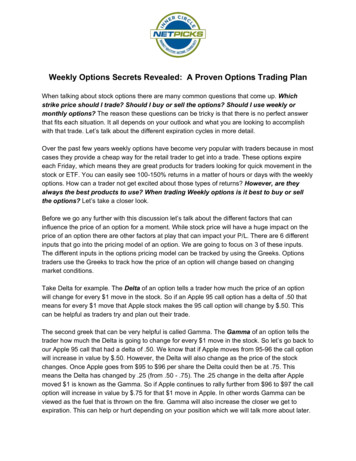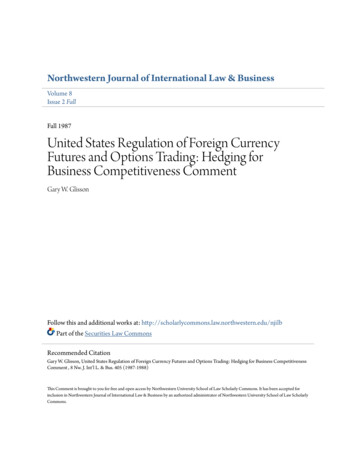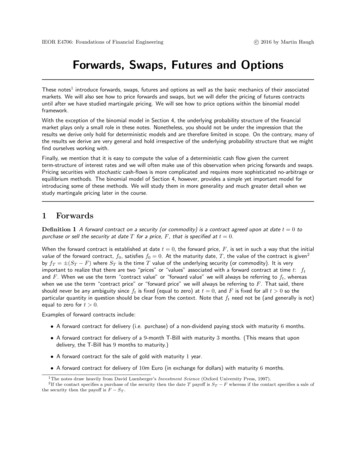
Transcription
IEOR E4706: Foundations of Financial Engineeringc 2016 by Martin HaughForwards, Swaps, Futures and OptionsThese notes1 introduce forwards, swaps, futures and options as well as the basic mechanics of their associatedmarkets. We will also see how to price forwards and swaps, but we will defer the pricing of futures contractsuntil after we have studied martingale pricing. We will see how to price options within the binomial modelframework.With the exception of the binomial model in Section 4, the underlying probability structure of the financialmarket plays only a small role in these notes. Nonetheless, you should not be under the impression that theresults we derive only hold for deterministic models and are therefore limited in scope. On the contrary, many ofthe results we derive are very general and hold irrespective of the underlying probability structure that we mightfind ourselves working with.Finally, we mention that it is easy to compute the value of a deterministic cash flow given the currentterm-structure of interest rates and we will often make use of this observation when pricing forwards and swaps.Pricing securities with stochastic cash-flows is more complicated and requires more sophisticated no-arbitrage orequilibrium methods. The binomial model of Section 4, however, provides a simple yet important model forintroducing some of these methods. We will study them in more generality and much greater detail when westudy martingale pricing later in the course.1ForwardsDefinition 1 A forward contract on a security (or commodity) is a contract agreed upon at date t 0 topurchase or sell the security at date T for a price, F , that is specified at t 0.When the forward contract is established at date t 0, the forward price, F , is set in such a way that the initialvalue of the forward contract, f0 , satisfies f0 0. At the maturity date, T , the value of the contract is given2by fT (ST F ) where ST is the time T value of the underlying security (or commodity). It is veryimportant to realize that there are two “prices” or “values” associated with a forward contract at time t: ftand F . When we use the term “contract value” or “forward value” we will always be referring to ft , whereaswhen we use the term “contract price” or “forward price” we will always be referring to F . That said, thereshould never be any ambiguity since ft is fixed (equal to zero) at t 0, and F is fixed for all t 0 so theparticular quantity in question should be clear from the context. Note that ft need not be (and generally is not)equal to zero for t 0.Examples of forward contracts include: A forward contract for delivery (i.e. purchase) of a non-dividend paying stock with maturity 6 months. A forward contract for delivery of a 9-month T-Bill with maturity 3 months. (This means that upondelivery, the T-Bill has 9 months to maturity.) A forward contract for the sale of gold with maturity 1 year. A forward contract for delivery of 10m Euro (in exchange for dollars) with maturity 6 months.1 Thenotes draw heavily from David Luenberger’s Investment Science (Oxford University Press, 1997).the contact specifies a purchase of the security then the date T payoff is ST F whereas if the contact specifies a sale ofthe security then the payoff is F ST .2 If
Forwards, Swaps, Futures and Options1.12Computing Forward PricesWe first consider forward contracts on securities that can be stored at zero cost. The origin of the term “stored”is that of forward contracts on commodities such as gold or oil which typically are costly to store. However, wewill also use the term when referring to financial securities. For example, while non-dividend paying stocks andzero-coupon bonds may be stored at zero cost, it is also the case that dividend paying stocks and coupon payingbonds can be stored at a negative cost.Forward Contracts on Securities with Zero Storage CostsSuppose a security can be stored at zero cost and that short3 selling is allowed. Then the forward price, F , att 0 for delivery of that security at date T is given byF S/d(0, T )(1)where S is the current spot price of the security and d(0, T ) is the discount factor applying to the interval [0, T ].Proof: The proof works by constructing an arbitrage portfolio if F 6 S/d(0, T ).Case (i): F S/d(0, T ): Consider the portfolio that at date t 0 is short one unit of the security, lends Suntil date T , and is long one forward contract. The initial cost of this portfolio is 0 and it has a positive payoff,S/d(0, T ) F , at date T . Hence it is an arbitrage.Case (ii): F S/d(0, T ): In this case, construct the reverse portfolio and again obtain an arbitrageopportunity.Example 1 (A Forward on a Non-Dividend Paying Stock)Consider a forward contract on a non-dividend paying stock that matures in 6 months. The current stock priceis 50 and the 6-month interest rate is 4% per annum. Compute the forward price, F .Solution: Assuming semi-annual compounding, the discount factor is given by d(0, .5) 1/1.02 0.9804.Equation (1) then implies that F 50/0.9804 51.0.Forward Contracts on Securities with Non-Zero Storage CostsSuppose now that we wish to compute the forward price of a security that has non-zero storage costs. We willassume that we are working in a multi-period setting and that the security has a deterministic holding cost ofc(j) in period j, payable at the beginning of the period. Note that for a commodity, c(j) will generally representa true holding cost, whereas for a stock or bond, c(j) will be a negative cost and represent a dividend or couponpayment.Forward Price for a Security with Non-Zero Storage Costs: Suppose a security can be stored forperiod j at a cost of c(j), payable at the beginning of the period. Assuming that the security may also be soldshort, then the forward price, F , for delivery of that security at date T (assumed to be M periods away) is givenbyM 1Xc(j)S (2)F d(0, M )d(j,M)j 0where S is the current spot price of the security and d(j, M ) is the discount factor between dates j and M .Proof: As before, we could prove (2) using an arbitrage argument. An alternative proof is to consider thestrategy of buying one unit of the security on the spot market at t 0, and simultaneously entering a forwardcontract to deliver it at time T . The cash-flow associated with this strategy is( S c(0), c(1), . . . , c(j), . . . , c(M 1), F )3 The act of short-selling a security is achieved by first borrowing the security from somebody and then selling it in themarket. Eventually the security is repurchased and returned to the original lender. Note that a profit (loss) is made if thesecurity price fell (rose) in value between the times it was sold and purchased in the market.
Forwards, Swaps, Futures and Options3and its present value must (why?) be equal to zero. Since the cash-flow is deterministic we know how tocompute its present value and we easily obtain (2).Example 2 (A Bond Forward)Consider a forward contract on a 4-year bond with maturity 1 year. The current value of the bond is 1018.86,it has a face value of 1000 and a coupon rate of 10% per annum. A coupon has just been paid on the bondand further coupons will be paid after 6 months and after 1 year, just prior to delivery. Interest rates for 1 yearout are flat at 8%. Compute the forward price of the bond.Solution: Note that in this problem, the ‘storage costs’ (i.e. the coupon payments) are paid at the end of theperiod, which in this example is of length 6 months. As a result, we need to adjust (2) slightly to obtainM 1XSc(j)F .d(0, M )d(j 1, M )j 0In particular, we now obtainF 501018.86 50d(0, 2)d(1, 2)where d(0, 2) 1.04 2 and d(1, 2) d(0, 2)/d(0, 1) 1.04 1 .1.2Computing the Value of a Forward Contract when t 0So far we have discussed how to compute F F0 , the forward price at date 0 for delivery of a security at dateT . We now concentrate on computing the forward value, ft , for t 0. (Recall that by construction, f0 0.)Let Ft be the current forward price at date t for delivery of the same security at the same maturity date, T .Then we haveft (Ft F0 ) d(t, T ).(3)Proof: Consider a portfolio that at date t goes long one unit of a forward contract with price Ft and maturityT , and short one unit of a forward contract with price F0 and maturity T . This portfolio has a deterministiccash-flow of F0 Ft at date T and a deterministic cash-flow of ft at date t. The present value at date t of thiscash-flow stream, (ft , F0 Ft ) must be zero (why?) and hence we obtain (3).1.3Tight MarketsExamination of equation (2) implies that the forward price for a commodity with positive storage costs shouldbe increasing in M . Frequently, however, this is not the case and yet it turns out that arbitrage opportunities donot exist. This apparent contradiction can be explained by the fact that it is not always possible to shortcommodities, either because they are in scarce supply, or because holders of the commodity are not willing tolend them to would-be short sellers. The latter situation might occur, for example, if the commodity has autility value over and beyond its spot market value.If short selling is not allowed, then the arbitrage argument used to derive (2) is no longer valid. In particular, wecan only conclude thatM 1XSc(j)F .(4)d(0, M )d(j, M )j 0Exercise 1 Convince4 yourself that we can indeed only conclude that (4) is true if short-selling is notpermitted.4 SeeLuenberger, Chapter 10, for a discussion of tight markets.
Forwards, Swaps, Futures and Options4In such circumstances, we say that the market is tight. An artifice that is often used to restore equality in (4) isthat of the convenience yield. The convenience yield, y, is defined in such a way that the following equation issatisfied.M 1XSc(j) y .(5)F d(0, M )d(j, M )j 0The convenience yield may be thought of as a negative holding cost that measures the convenience per periodof having the commodity on hand.2SwapsAnother important class of derivative security are swaps, perhaps the most common of which are interest rateswaps and currency swaps. Other types of swaps include equity and commodity swaps. A plain vanilla swapusually involves one party swapping a series of fixed level payments for a series of variable payments.Swaps were introduced primarily for their use in risk-management. For example, it is often the case that a partyfaces a stream of obligations that are floating or stochastic, but that it will have to meet these obligations witha stream of fixed payments. Because of this mismatch between floating and fixed, there is no guarantee that theparty will be able to meet its obligations. However, if the present value of the fixed stream is greater than orequal to the present value of the floating stream, then it could purchase an appropriate swap and thereby ensurethan it can meet its obligations.2.1Plain Vanilla Interest Rate SwapsIn a plain vanilla interest rate swap, there is a maturity date, T , a notional principal, P , and a fixed5 number ofperiods, M . There are two parties, A and B say, to the swap. Every period party A makes a payment to partyB corresponding to a fixed rate of interest on P . Similarly, in every period party B makes a payment to party Athat corresponds to a floating rate of interest on the same notional principal, P .It is important to note that the principal itself, P , is never exchanged. Moreover, it is also important to specifywhether the payments occur at the end or the beginning of each period.For example, assuming cash payments are made at the end of periods, i.e. in arrears, the total aggregate cashcash flow from party A’s perspective is given byC P (0,r0 rf {z }At end of 1stperiod, . ,rM 1 rf {z }At end of Mth)periodwhere rf is the constant fixed rate and ri is the floating rate that prevailed at the beginning of period i. Ingeneral, ri will be stochastic and so the swap’s cash-flow, C, will also be stochastic. As is the case with forwardcontracts, the value X (equivalently rf ) is usually chosen in such a way that the initial value of the swap is zero.Even though the initial value of the swap is zero, we say that party A is “long” the swap and party B is “short”the swap.Exercise 2 Make sure you understand how to use the terms “long” and “short” when referring to a swap.2.2Currency SwapsA simple type of currency swap would be an agreement between two parties to exchange fixed rate interestpayments and the principal on a loan in one currency for fixed rate interest payments and the principal on a loanin another currency. Note that for such a swap, the uncertainty in the cash flow is due to uncertainty in thecurrency exchange rate. In a Dollar/Euro swap, for example, a US company may receive the Euro payments of5 Itis assumed that the date of the terminal payment coincides with the maturity date, T .
Forwards, Swaps, Futures and Options5the swap while a German company might receive the dollar payments. Note that the value of the swap to eachparty will vary as the USD/Euro exchange rate varies. As a result, the companies are exposed to foreignexchange risk but if necessary this risk can be hedged by trading in the forward foreign exchange market.Why might the US and German companies enter such a transaction? A possible explanation might be that theUS company wishes to invest in the Eurozone while the German country wishes to invest in the U.S. Eachcompany therefore needs foreign currency. However, they may have a comparative advantage borrowing in theirdomestic currency at home as opposed to borrowing in a foreign currency abroad. If this is the case, it makessense to borrow domestic currency at home and use a swap to convert it into the foreign currency.2.3Pricing SwapsPricing swaps is quite straightforward. For example, in the currency swap described above, it is easily seen thatthe swap cash-flow is equivalent to being long a bond in one currency and short the b
Forwards, Swaps, Futures and Options 2 1.1 Computing Forward Prices We rst consider forward contracts on securities that can be stored at zero cost. The origin of the term \stored" is that of forward contracts on commodities such as gold or oil which typically are costly to store. However, we will also use the term when referring to nancial securities. For example, while non-dividend paying stocks andFile Size: 395KBPage Count: 16
